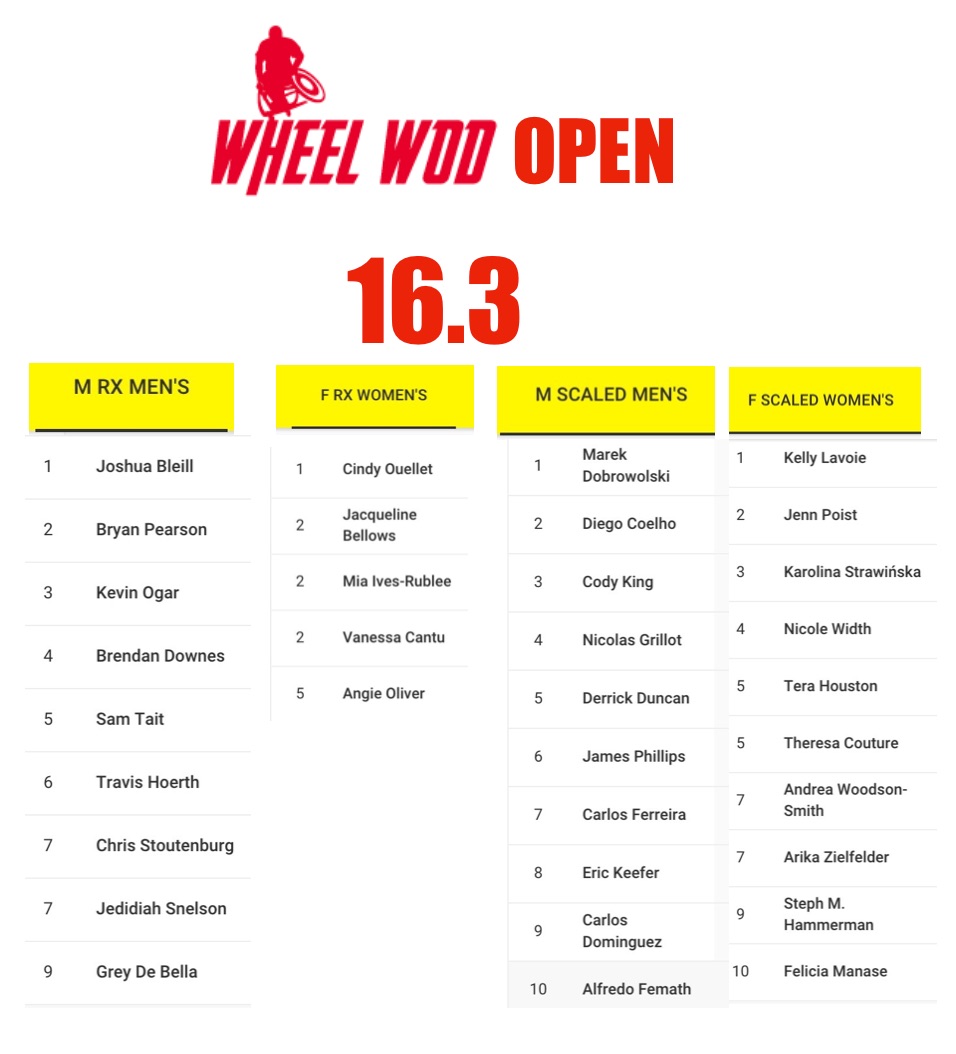WOD 1 – Wodapalooza Week 1
| Adaptive Standing | Adaptive Seated |
| 100 DU
60 WB 20/14 – (SAA 14/10) 30 C2B 100 DU |
75 Left Arm Battle Ropes (15’ long)
75 R. Arm Battle Ropes 50 WB 14/10 @9’/7’ 30 full hang pull ups 75 L. Arm Battle Ropes 75 R. Arm Battle Ropes |
Scaled Option – Adaptive Divisions
Standing
75 Unloaded BB Lateral Jump Overs
60 Wallballs (14, 10lbs) @ 9/8ft
30 Jumping C2B
75 Unloaded BB Lateral Jump Overs
Seated
75 Left Arm Battle Ropes
75 R. Arm Battle Ropes
50 WB 14/10 @7’/6’
20 seated Pull ups
75 Left Arm Battle Ropes
75 R. Arm Battle Ropes
Equipment
Wallball & 10 or 9ft Target, Pull-up Bar, Jump Rope, Scaled: Barbell
Score: For Time
Tie-breaker: Time at completion of the wallballs
Workout 1 Flow
Workout 1 is a “for-time” event, that begins with the athlete standing tall, jump-rope in hand.
At the start of the ascending clock, the athlete may begin with double-unders. Upon accumulation of the required 150 repetitions, they will then advance to the wallballs. Upon completion of their 60 wallball repetitions, the athlete and/or judge will note the time, as this will be used as the tie-breaker.
They will then advance to the pull-up bar to complete the required number of chest-to-bar pull-ups. Once finished, they will again return to the jump rope, to accumulate 150 double-unders.
Upon completion of the final double-under, time will be called which will be noted as the athletes score: total time to complete the above workout.
Adaptive
Movement Standards-
Double-Under – Standing
The double-under requires the athlete complete two rotations of the rope beneath the athletes feet for every singular jump. If the rope does not pass beneath the athletes feet twice, such as tripping on the rope during the second rotation, that rep shall not count.
1 arm Battle Rope ( Left & Right)- Seated
For the 1 arm battle rope swing, athletes will sit with a 15 foot climbing rope full extended & anchored on the end to weight or solid point. The full 75 reps must be completed before moving on to the next arm.
A rep will be considered complete if the wave generated from the swing of the athletes arm continues the full length of the rope. If the rope does not have a wave generated and stops before the anchor point the rep will not count.
Wallball – Standing
For the wallball, the athlete must start with the ball at a dead stop on the ground. The athlete may then pick up the ball and stand tall before beginning a set, or squat clean the ball, before beginning their first repetition of any set. An athlete may not start in a squat, pick up the ball from this position, and toss the ball to the target.
A repetition consists of an athlete holding the ball in the at shoulder height and performing a full squat, hip-crease passing below the top of the knee, and when vertically extending throwing the ball to a specific target height. (SLA athletes may squat to a box set below parallel) If the athlete’s hip does not break parallel, or the target does not touch the wall, that rep will not be counted.
The athlete may then catch the ball and perform multiple reps if they so choose.
Finally, athletes may not catch the ball on the bounce, and head right into a Wallball repetition. The ball must be settled on the floor before picking it up to begin another set.
Scaled
Wallball – Seated
Wall Ball starts in the athletes hands in a seated position. If an athlete needs to sit on box instead of chair. max height of box is 20 inches and must be shown in video.
Athlete will throw the ball with 2 limbs up to target line on wall. Medball must clear 9/7 ft according to your division. Ball must hit clearly over the identified marker. The marker height, ball weight must be shown clearly in the video before the WOD start.Scaled 14/10 @ 7/6′
Chest-to-Bar – Standing
The chest to bar pull-up begins with an athlete at a dead-hang (arms, shoulders, and hips extended) from a pull-up rig. The athlete then, using any style (kipping, butterfly, strict,) must draw anywhere from their clavicle to their first rib in physical contact with the bar. Each repetition begins with the athlete in a dead-hang, and finishes with the athlete making contact with their chest to the bar. Single arm athletes may use a band to replace a limb creating 2 points of contact on the pull up bar.
Full Hang Pull-Up – Seated
Athlete will start seated under the pull up bar. The athlete will then reach up grab bar fully extended set up in full Hang position buttox can not touch on the floor and arms must be fully extended. Each rep must start with this full arm extended hang position, feet just touching floor and arms at full extension. At the top of the rep athlete must clear chin above pull up bar and feet off the floor to be considered a successful rep. The athlete then must return to starting position in full Hang before attempting next rep. Female athletes may keep feet on floor at all times during the rep.
Athlete may rest on chair or box between reps but before starting next rep they must reach full hang at the bottom again.
Butterfly, kipping, Strict, switch grip or chin up grip are all acceptable as long as the above standards are met
Seated Pull-Up -scaled
Athlete will position a pull up bar where they are seated in chair or box and arms at full extension.
To set up in extension position, feet can remain on the chair foot rest. Each rep must start with this full arm extended seated position, butt on seat and arms at full extension. At the top of the rep athlete must clear chin above pull up bar to be considered a successful rep. The athlete then must return to starting position in full extension before attempting next rep.
Unloaded BB Lateral Jump Overs – Standing scaled
This movement requires an athlete start with an empty barbell, with no loaded plates or clips. The athlete will start, standing parallel to the bar, with both feet on one side of the barbell. To perform a repetition, the athlete can then jump laterally with two feet to the other side of the barbell, or step over the barbell, finishing each repetition with both feet in contact with the floor on the opposite side of the barbell.
Jumping Chest-to-Bar – Standing scaled
This movement requires the athlete to set up a box or platform beneath a pull-up rig. The box should be set up so that when the athlete is standing at full extension with arms overhead and locked out, the pull-up bar meets them roughly three inches below the start of their wrist. Single arm athletes may use a band to replace a limb creating 2 points of contact on the pull up bar.
FAQ
Adaptive Specific FAQ
What is SAA or SLA?
SAA= Single Arm Athlete & SLA= Single leg athletes.
These athletes will be classified as 1 point of contact on the equipment or floor. These athletes will receive % deductions on prescribed weights. As well be allowed to replace upper limbs with bands and support lower limb with a box at parallel for squats or safety.
WOD 2&3 – Wodapalooza Week 1
| Adaptive Standing | Adaptive Seated |
| WOD 2
145/85 SAA- 110/65 SLA – 130/75 WOD 3 SAA@ 25% MULTIPLIER SLA@ 10% MULTIPLIER
|
WOD 2
85/40 Higher Injury – 75/35 WOD 3 Higher Injury @ 10% Multiplier
|
SCALED STANDING OPTIONS
Scaled 95/65
SAA- 70/50
SLA – 85/55
SCALED SEATED OPTIONS
55/25
Week 1, WOD 2 & 3 Description
Equipment
Barbell, clips & full-set of plates
WOD 2 Score: Total Clean & Jerks Performed
WOD 3 Score: Heaviest Clean & Jerk Performed
Tie-breaker for WOD 2: Clean & Jerk Load on WOD 3
Tie-breaker for WOD 3: Total Clean & Jerks performed on WOD 2
Workout 2 & 3 Flow
WOD 2 & 3 begins with a barbell pre-set to a specific weight. At the start of the eight minute clock, the athlete will use the first three minutes to perform as many clean & jerks as possible, any style.
At the conclusion of the first three minutes, WOD 2 is done, and the score is the total number of reps completed.
The clock will then continue, and minute 3:00 to minute 5:00 is considered a rest period. The athlete may do whatever they like during this time, including change the weight on the barbell in preparation for the start of WOD 3.
At the 5:00 mark, WOD 3 begins. From minute 5:00 to minute 8:00, the athlete shall build up in weight to establish their heaviest possible clean & jerk, any style. The athlete may increase and decrease weight during the two minute rest period, and during this three minute window however they so please.
All attempts must be completed by the 8:00 mark, at which point WOD 3 is complete.
Please note, you must have clips on the bar when performing clean and jerks for both WOD 2 & WOD 3.
Movement Standards
Clean & Jerk
For the clean & jerk on WOD 2 & 3, any style of clean, and any style of jerk is permitted. This simply means the barbell must originate on the floor, arrive at the athlete’s shoulder, and finish with the barbell locked out overhead, with the athlete’s hips, knees, shoulders, and arms at full extension, with the barbell over the athlete’s center of mass.
Some examples of permissible reps include a power clean, split clean, hang clean, squat clean, hang squat clean, into a strict press, push press, push jerk, or split jerk.
If the athlete completes the clean, but not the jerk, that rep will not be counted.
Seated athletes The Bar will start and finish in the lap not the floor. This simply means the barbell must originate on the boxes set at lap height and, arrive at the athlete’s shoulder, and finish with the barbell locked out overhead, with the athlete’s shoulders over hips, and arms at full extension, with the barbell over the athlete’s center of mass. Curling the bar will not be allowed, the grip must be palms down, bouncing the bar off the boxes will also not be allowed.
Seated athlete are strongly advised to lift bar from boxes. When the barbell is loaded with weight the bar may not be more than 3 inches above the lap. This measurement must be shown in video standards.
Can the athlete have assistance loading the bar? Yes 1 helper may assist.
FAQ
–Change plates- an athlete may use change plates, but the final total weight must be rounded DOWN to the nearest single pound. No decimal pounds will be accepted.
-Do I need clips? Yes. Any athlete deemed not using clips for any attempts will not be counted.
-Can you explain the tie-breaker?
Sure! Your score on WOD 2 (total clean & jerks,) is the tie-breaker for WOD 3, and your score on WOD 3 (heaviest C&J) is the tie-breaker for WOD 2. So basically, as an example, if two athletes both hit a 315lb Clean & Jerk on WOD 3, but one athlete gets three more repetitions on WOD 2, they win the tie-breaker.



